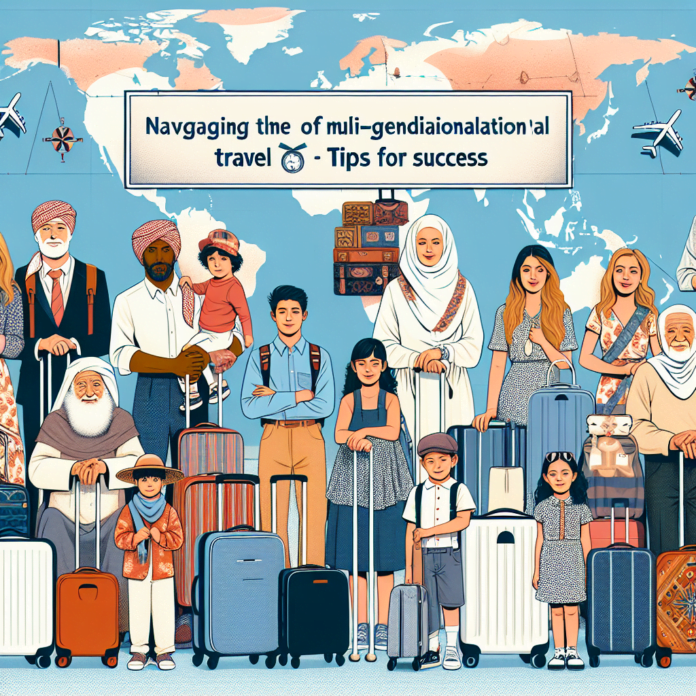The idea of multi-generational travel, where grandparents, parents, and children all embark on a trip together, is not new. However, it is a concept that is rapidly gaining popularity, appealing to families keen on creating memorable experiences together. It presents an opportunity for older generations to bond with the younger ones outside their customary environments, allowing them to share traditions, values, and pastimes. But, weaving together an itinerary that caters to a wide age range is undoubtedly a daunting task. How do you ensure that every family member, from the sprightly grandchild to the able-bodied grandparent, is engaged, entertained, and catered for?
1. Planning:
When planning a multi-generational trip, it’s essential to involve everyone. Listen to the preferences, interests, and concerns of each family member. Does grandpa prefer a serene environment? Are the kids drawn to adventure and excitement? This is not to say that every event on the itinerary must be all-inclusive. It is okay to arrange activities that cater specifically to the younger or older groups, as long as everyone has several occasions where they can gather and bond as a family. This cultivates a sense of ownership and anticipation across the board. The key is to strike a balance to ensure everyone feels catered to at different points in the trip.
2. Choosing the Right Destination:
In selecting a destination, it is crucial to consider the physical abilities and restrictions of your group members. As a rule of thumb, select a location that is easily accessible and has good healthcare facilities. Choose a destination that offers diverse attractions to cater to the varied tastes within your group. Think theme parks, museums, wildlife reserves, historical sites – places that offer a range of activities for all ages and physical capabilities.
3. Accommodation:
Accommodation plays a key role in determining the comfort and convenience of your family members throughout the trip. Renting a house, villa, or apartment can often be a more feasible option compared to booking individual hotel rooms. Shared living spaces offer opportunities for bonding and are typically easier on your wallet. However, ensure that the place is elderly-friendly if you have older family members. Look out for features like wheelchair accessibility, grab bars in the bathrooms, and minimal stairs.
4. Picking the Right Time:
When planning your trip’s timing, consider factors such as the school schedule for kids, work commitments for adults, and weather conditions at your chosen destination. Avoid peak tourist seasons to stay away from crowded attractions and high prices. The time of travel should also accommodate the health and convenience of all involved.
5. Packing Necessities:
Always pack keeping in mind the needs of every generation. For younger kids, games, snacks, and familiar comfort items can be helpful. Remember to store medications, health supplies, and any special dietary foods for older participants. Don’t forget the essentials like travel documents, clothing suitable for the destination’s weather, and travel insurance papers for all family members, if applicable.
6. Keeping Expectations Realistic:
Remember, even with the most meticulous planning, things can go wrong. The key is to remain flexible. Adjust your plans if needed. Multi-generational travel is about enjoying each other’s company, learning from each other, and creating shared memories. The focus should be on promoting bonding and achieving quality family time.
Conclusion
In conclusion, successful multi-generational travel requires thoughtful planning to tackle the unique challenges it presents. However, the reward – a fulfilling shared experience that strengthens familial bonds and creates lasting memories – is well worth the effort. The tips discussed in this article should go a long way towards ensuring that your multi-generational travel experience is a smooth and enjoyable one.
FAQs
1. What is multi-generational travel?
Multi-generational travel involves traveling with family members from different generations, such as grandparents, parents, and children.
2. How can I cater to various age groups during the trip?
Choose a destination that offers diverse attractions and include activities that cater to the interests of different age groups in your itinerary. Also, ensure comfortable accommodations and schedule downtime for rest.
3. What should I consider when choosing accommodations?
Ensure that the accommodation is comfortable for all family members. For elders, look for facilities like wheelchair accessibility and minimal stairs. Shared accommodations are often ideal as they offer opportunities for family bonding.
4. How can I manage expectations during multi-generational travel?
Communicate prominently during planning to set clear expectations. Stay flexible during the trip as plans may need adjustments. Remember, the essence of multi-generational travel is to strengthen family bonds and create shared memories.
5. What are some essentials to pack for a multi-generational trip?
Consider the needs of all generation groups. Pack games and snacks for kids; medications, health supplies, and dietary foods for elders; and crucial travel documents and clothing for all.

